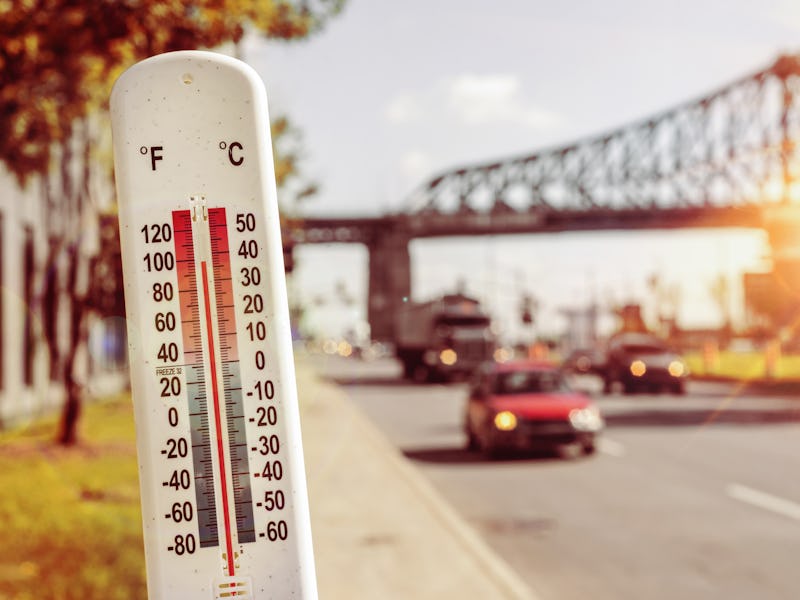4 of the worst heat waves in the last 60 years went unrecorded — here's why
A new study retrieves what slipped through the cracks.

Summer in the Northern Hemisphere is fast approaching. This season means long, sunny days, beach trips, the best fruits, and, unfortunately, the risk of extreme heatwaves.
In June 2021, a record-breaking heatwave swept through the western part of North America. Heatwaves aren’t as simple as cranking the air conditioning up; they can create life-threatening conditions.
India and Pakistan, where 21 percent of the world’s population resides, are currently in the midst of a deadly heatwave. As the climate crisis rages, more vulnerable populations in developing countries will continue to bear the brunt of its consequences.
According to a recent study, even more extreme heatwaves may have passed over the world that scientists were unaware of. Researchers from the University of Bristol in England re-analyzed climate data from the 1950s onward. Disturbingly, the June 2021 event ranks among the top eight worst heat waves since then, with others scattered across the globe. The findings were published last week in the journal, Science Advances.
What’s new — With a combination of available data and climate models, the new report details some of the worst heatwaves worldwide that went unnoticed, including the worst one in magnitude in Southeast Asia in 1998. The researchers looked not only for the biggest numbers in terms of temperature or duration but also for what constituted a heatwave for a particular region. For example, summertime temperatures of 100 degrees Fahrenheit in Arizona might be typical, but not in British Columbia, where last June heat scorched at 122 degrees. According to the Coroners Service, nearly 600 people in the region died from heat deaths between June 18 and August 12, 2021.
This study fills a gap, according to lead author Vikki Thompson. Most research focuses on a particular region or event, she tells Inverse. “Looking globally gives us a different kind of picture of what's happening...and also allows us to put future events into better context, because even if one region hasn't had [a heat wave], we can show that other parts of the world may have experienced similar things already.” Thompson is a senior researcher at the University of Bristol’s School of Geographical Sciences.
Why it matters — Heatwaves can devastate communities.
“Literally, communities started to burst into flames,” Robert McLeman, a geography and environmental studies professor at Wilfrid Laurier University, tells Inverse of the heatwave in British Columbia in 2021. “It was just so hot and so dry, we had wildfires, we had towns that were literally burnt off the map.” McLeman was not involved with the new study.
Towns like those in British Columbia, which rarely get such extreme heat, don’t have infrastructure like massive cooling centers or central air conditioning to alleviate their people. McLeman says that after temperatures reach about 120 degrees Fahrenheit, it’s not safe to be outside. With heat above 100 degrees, manual labor and time outside taxes the body exponentially more. Those who live alone are especially vulnerable because they may not be able to call for help in dire moments.
This study also sheds light on populations that get less attention. Part of why there’s more news on climate in North America and western Europe is because that’s where many climate scientists live, according to Thompson. Huge chunks of data end up missing from multiple countries, or even an entire region in a continent. “We had to leave out parts of Africa because datasets don't agree over what's happening,” Thompsons says. “There isn't enough observational data from them.”
Digging into the details — If there have been more extreme heat events that scientists didn’t notice, some may wonder, doesn’t that mean the climate hasn’t actually been warming, but rather inaccurately recorded?
This is where mathematical modeling comes in, says both Thompson and McLeman. Researchers create their models based on observational data they do have to calculate the likelihood of a weather event at a particular point in history in a certain region. To test the accuracy of their models, researchers make “predictions” about the weather during time periods that have already happened and for which they have data. They then can compare the models with the observed data.
How people learn to respond to extreme weather has as much of an impact as the weather itself, Thompsons says. Studying other populations suffering extreme, anomalous heat can be useful in preparing, especially for other regions that aren’t usually so hot.
What’s next — Thompson hopes future research will target regions with changing climates. She also focuses on sanitation and precipitation impacts in Ethiopia, Uganda, and Nepal, so she hopes to provide more clarity on some less-observed countries.
McLeman wants to see strides in infrastructure and urban planning research before the next heatwave. “How do we build into our infrastructure to cope with these extremes, because they are going to become more frequent, especially in areas where we're not really used to having such extreme temperatures.”
Editor's note: This article has been updated to properly reflect the percent of the world's population that India and Pakistan encompass. The two countries make up 21 percent of the population, not 25 percent, as previously stated.